on seville
A sun-soaked city that radiates the color orange seemingly from the inside out, Sevilla drips with delicious food, a deep history and culture, and flourishing night life.
Harrison and I rolled into Seville on the tailcoats of eight days in the incredibly tourist-packed cities of Porto and Lisbon. In fact, we were almost bewildered by the sheer number of visitors in these cities, and, with our border crossing, were hoping for somewhat of a reprieve from the droves of selfie-takers.
The problem with tourists, we have found, isn’t necessarily the people themselves—although some tourists are horribly disrespectful and rude—rather, it’s the contrived atmosphere that seems to develop whenever a place becomes a popular travel destination. A boom in popularity causes a city to grow a calloused layer of tough skin that prevents you from seeing its true culture, the way the locals live their lives, the nuanced differences between this city and yours, rather than getting the one famous regional dish shoved down your gullet every place you go to eat, followed by the dessert that’s shaped like the local chain of mountains over yonder.
Our tummies were rumbling as we got off the bus, so we slammed our stuff down at the hostel and went back out for a bite. The clock seemed to stop ticking as the sun began to go down; people were settling in for their reservations at various restaurants, safe now to eat outside because the sun was beginning to disappear. The first observations of Seville: extremely hot and dry.
As we walked through snaked and curvy alleyways, we saw some hallmarks of a touristic city: carts full of little pieces of plastic with “Sevilla” written on them in kitschy fonts with the Plaza de España in the background, people walking past us at the paces of snails wearing Keen sandals and capris, signs outside restaurants advertising quintessential Andalusian tapas dishes. I began to get worried that it would be just as hard to find the soul of Seville as it had been to find the soul of Lisbon or Porto.
Therefore, I was even more determined to seek out a genuine dinner spot serving delicious classic Andalusian food that wouldn’t be a tourist trap—that would allow us to scrub off the callous and see below the surface. So we wandered the winding, narrow alleys that would randomly break out into squares, looking for a spot that got decent reviews on Google Maps. I was looking for words like “hidden gem,” “underrated,” and “local.”
And then we found Bar Kiko.
Down a dark alley with a few diners at little tables outside the door, the tiny Bar Kiko de la Chari had no open tables for us, but they did have bar seats available. We sat and ordered brews, pleased that we were surrounded by conversations happening primarily in Spanish.
None of the restaurateurs behind the bar spoke English, but they were all incredibly enthusiastic in helping us order. Harrison’s American-school-level Spanish helped us figure out what they were telling us: Order the chicken nuggets.
The chicken nuggets? Seriously?
They were insistent. The restaurant was run by a family, and the matriarch had developed this dish to much local acclaim. Proof of this was on the wall behind us: Multiple, framed articles apparently raving about these chicken nuggets. So we had traveled all this way to try some nuggs.
Harrison took the bait and ordered the nuggs as a part of his three-tapas deal; I was pescatarian at the time so I did not. I opted instead for the ratatouille with a fried egg on top as well as the espinacas con garbanzos, the latter of which was full of spice and life and tasted almost Indian or Middle Eastern. Upon tasting the critically-acclaimed little fried chicken bites, Harrison did indeed say they were very, very good.
The quality of the food and hospitality we received for a very low price could not be beat, especially considering that eating “authentically” in a place is often more expensive, as it is the more touristy thing to do. Six dishes and three beers for 16,50 euro? That is a deal for me.
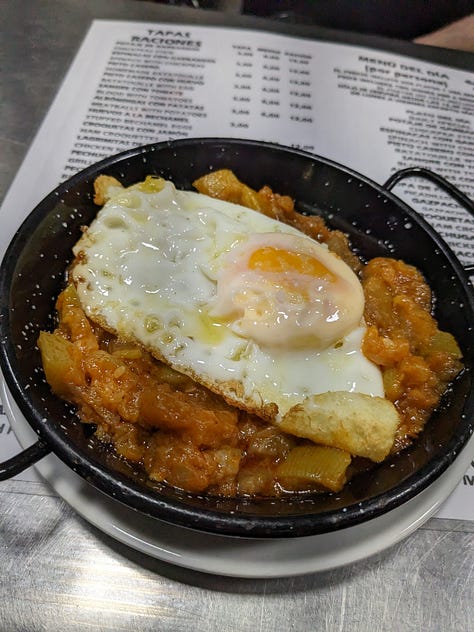
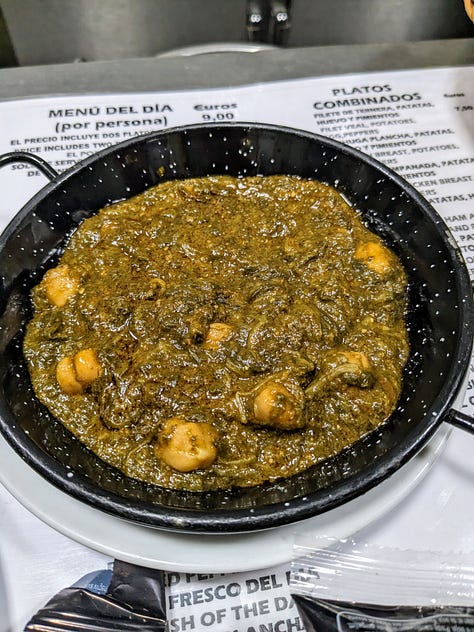

día dos: discovering the holy palmera
Mornings in Seville before the sun is raring are delicious. It is quiet, not unbearably hot, and the streets of the historic and therefore tourist-packed old town are yet to become crowded. Portugal had been hot, but it was nothing compared to this heat. Seville’s heat felt like it came from an entirely different sun, laughing at us from above and digging our shorts’ tan lines even deeper into our thighs.
We wandered the city aimlessly until soon enough, Harrison and I—unsurprisingly, as it was Europe—ended up passing a pastry shop. Ever suckers for a good window display of sweets, our eyes spied these massive, heart-shaped, chocolate-covered pastries that looked far too good to turn down. Neither of us had ever seen a pastry such as this one.
“Oh my gosh Harrison. Do you see that? What is that?”
“I don’t know.”
“…I think we need to try it.”
“I think we might.”
We looked at each other and marched in the cafe. We needed answers. This was research now.
Less than five minutes later we sat down on a bench adjacent to the cafe that had lured us in and took our first bites into the pastry that would earn a semi-permanent spot in my brain space for the next four weeks. These heart-shaped bundles of fat and flour, called "palmeras," are (usually massive) pastries that are flaky and soft like a croissant, with all the thick, sweet, buttery taste of shortbread. Very possibly the epitome of indulgence. This particular one was smothered in Nutella and brought on what only could have been a religious experience.
Post-palmera, we wandered into the Museo de Bellas Artes for an actual religious experience. For around 3 euro, we got access to halls and halls filled with gorgeous sacred works hosted in a stunningly historic 17th century building. A sublime afternoon activity to break from the sunny tyrant in the sky. Even if you’re not into religious works of art, the museum is worth it for the air conditioning, beautiful courtyards filled with gorgeous plants, and the angels in the paintings, as they are depicted with colorful parrot wings instead of dove wings, which I find to be hilarious, adorable, and a stroke of creative genius.
{Speaking of religious experiences—take whatever chance you have to walk into random churches in Seville, or in any part of Europe, for that matter. Despite any potential lack of personal religious affiliation, they are usually stunning works of art and architecture and a very peaceful escape from the madness that is often Europe in the summer months}
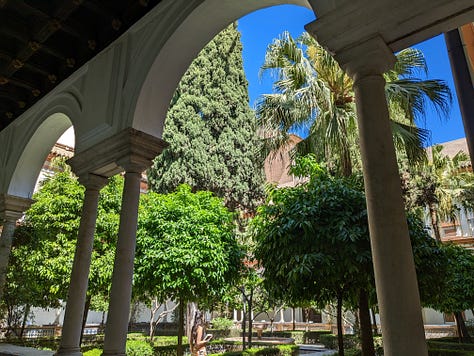
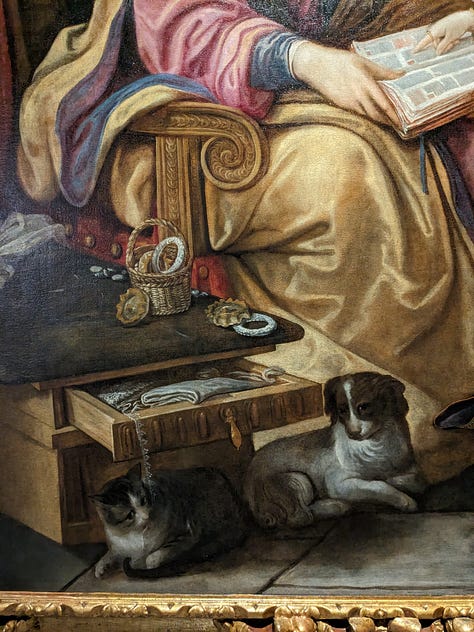
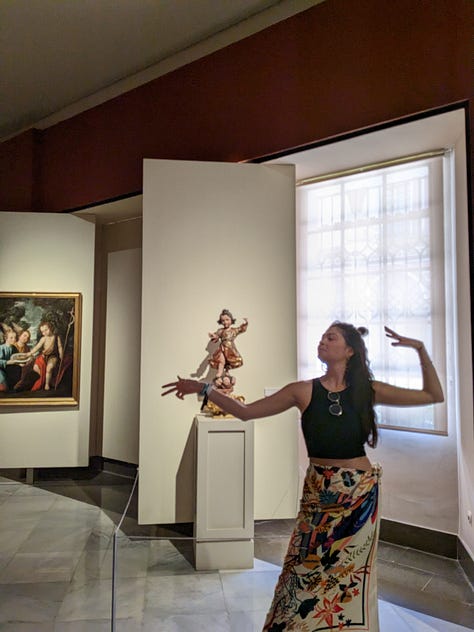
Harrison could’ve stayed in the museum looking at the art all day, but I soon got a bit restless, so we waltzed across the city in the direction of the Plaza de España, mayhaps the most famous of Seville’s buildings and destinations. It was grand, and I highly recommend it, especially for a free flamenco shows, but what I recommend more are the gardens adjacent to the Plaza. Called Parque de Maria Louisa, the sprawling garden paths are lined with shade-throwing trees that are much needed anytime after 10am and before sundown. Plus, I’m pretty sure the garden has the highest concentration of baby birds I’ve ever seen. Ducklings, baby swans, geese, loons, and more.
If you get thirsty, the park also sports several little “bier gardens”/cocktail bars like any good European park. You can stop and take a break from the insane Spanish sun with a delicious Estrella, Cruzcampo, or what-have-you—complete with complimentary little crunchy snacks, as is frequently the case in Spain (and we love her for that).
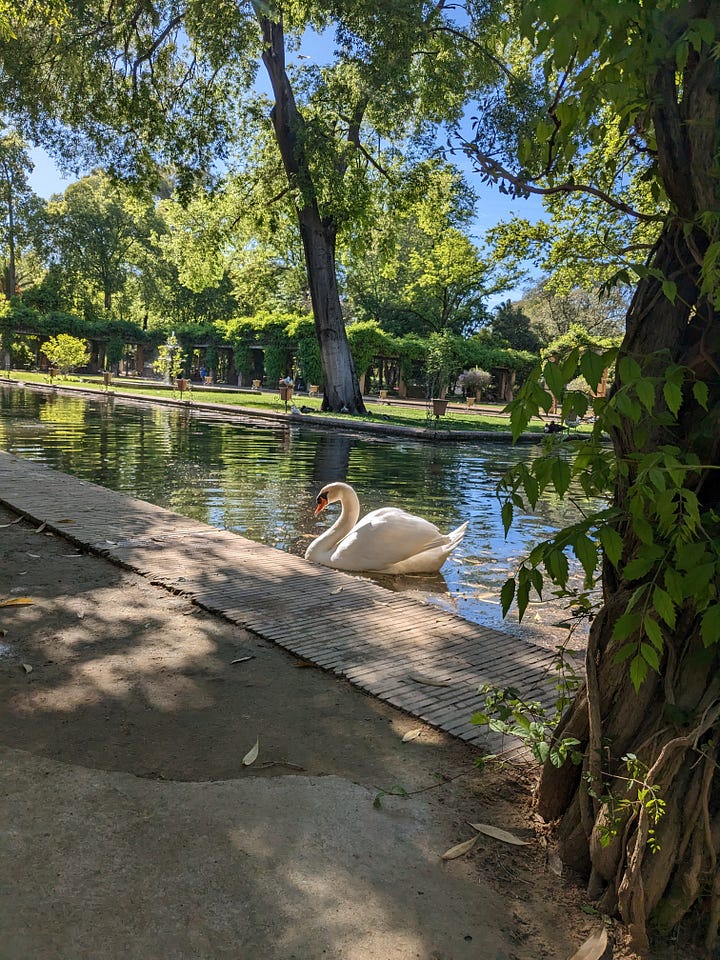
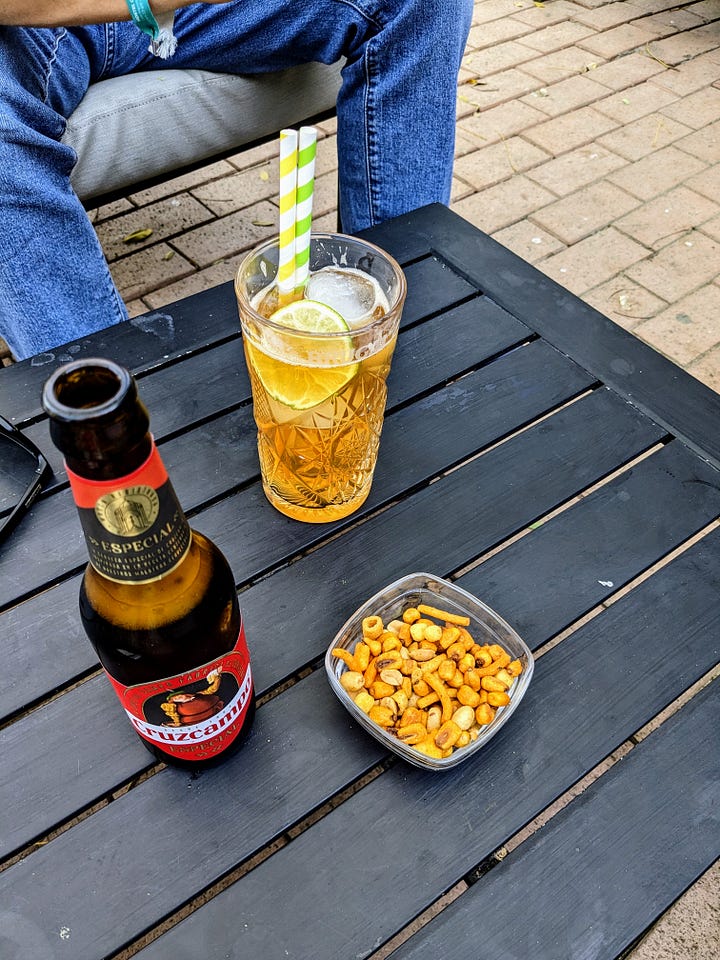
Post park-brew, we vetted around 15 tapas bars to find one that would once again be tasty and well-priced. It was indeed tasty and well-priced, and we got to try dishes such as croquettes, the infamous Spanish tortilla (the first of oh so many), and patatas bravas. But sometimes the best, most satisfying meals are the ones that are cheap, simple, and unceremonious. I wanted a little more protein in my belly, so I cracked open the Portuguese tin of needlefish I had stashed in my bag for emergencies and ate it with the free crackers from the restaurant while perched on the steps of a church. Perfectly toothsome and filling, this simple moment lives in my head as sublime.
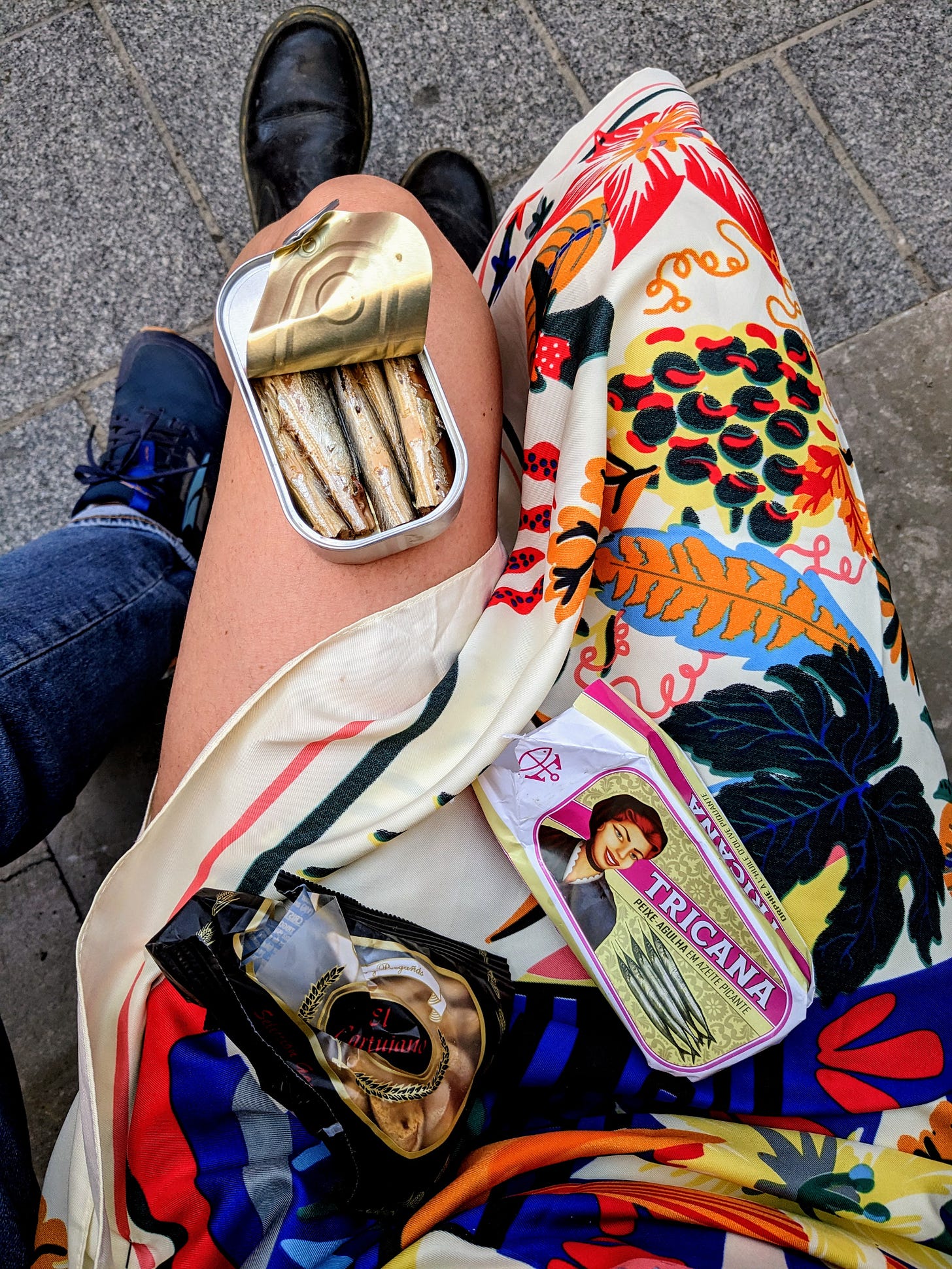
Our day was far from over at this point and would carry well into the next day as testament to Seville’s nightlife. Upon arriving back at our hostel, we were greeted by free sangria and several drinking games which we played until 10:30 p.m., at which point it was time to head to Alameda de Hercules. Alameda is a long, open air night market lined with bars and clubs in the Macarena neighborhood, AKA the “young,” “hip” part of Seville.
Our pack of hostel friends headed straight to a bar called 1000 Cocktelitos, or 1000 Cocktails. Indeed, it was called that because they had 1000 cocktails on their menu. Inside of 1000 Cocktelitos was the most insanely chaotic young people energy—I gathered that basically anyone staying at a youth hostel in the area had been taken here. So the place was packed with young college-aged kids from around the world all vying for the BOGO cocktail deal, trying to pick two out of literally a THOUSAND choices.
I stayed inside long enough to get a beer because there was simply no way I was going to wait for someone to mix me a cocktail, but Harrison waited in line for what ended up just being an incredibly stiff pour of whiskey (read: half a pint glass full of straight liquor). We met some Aussies at the bar and sat outside at a table on the street with a group of them. The whole street was buzzing with people drinking and talking.
Walking down the strip after finishing our drinks was slightly overwhelming, what with the night market happening along with the adjacent bar occupants spilling out onto the streets and the club music blaring in the background, and shortly after entering one of the “clubs,” we found ourselves leaving. The bar was wildly unmemorable; the music wasn’t good and it was clearly meant for meeting people to potentially take you home.
Walking back was a blur of fluorescent lights and various market stalls selling jewelry, trinkets, hats, clothing, and more. It faintly reminded me of the famous night markets in various parts of Asia.
We passed out a little after midnight with ringing in our ears from the bad club music. Ah, the sweet lullaby of college returneth.
día tres: alcazar, ice cream, and flamenco
Needless to say, the next morning was met with groggy heads and half-shut eyes. Harrison was wildly hungover, and I was suffering from an ungodly wave of period cramps. As we hobbled out of our bunk room and into the main hall of the hostel, we found ourselves in conversation with some tech bro Aussies who suggested we go to a coffee shop called “MUY” to nurse our hangovers with a dirty chai.
So we did just that. Walking into the coffee shop was like going back to Bocas del Toro in Panama. A far cry from the orangey brown, ancient European look of Seville, this place was bursting with tropical color and decor paying homage to the origin of their beans. Finding little shops or restaurants in cities and towns that clearly hail from a completely different part of the world are such interactive representations of the constant cultural exchange happening. Who would’ve thought that we would be partially revived by delicious dirty chais in Seville with coffee beans that came from the country we had last visited pre-Europe?
We had bought tickets to Alcazar Palace that afternoon and post-coffee, haggardly pulled up to the incredibly hot and tourist-packed entrance to ensure we didn’t miss our ticket time. Famously Dorne from Game of Thrones, this Spanish-Moorish castle is a sprawling complex of gardens and beautiful buildings. The palace’s stone structures were replete with some of the most consistently complex carvings I had ever seen. I thought that at some point the next room might prove less detailed, but, contrary to my assumption, they seemed ever more colorful and laborious. You could spend days examining room after room, trying to process the detail evident in every square inch of the place. Trying to aptly appreciate the work put into building something as lavish as this palace was nothing short of impossible.
I am very glad we took the time to walk not only the palace buildings, but also the gardens, as they contain a number of different pockets of flowers, trees, and brush, all manicured to perfection. We found a hedge maze, several serene fountains, a citrus grove, and plenty of peacocks meandering about all of it. We also stumbled upon a cute little cafe bordering the orchards that sells sweets, food, and has a bathroom, which was desperately needed halfway through.
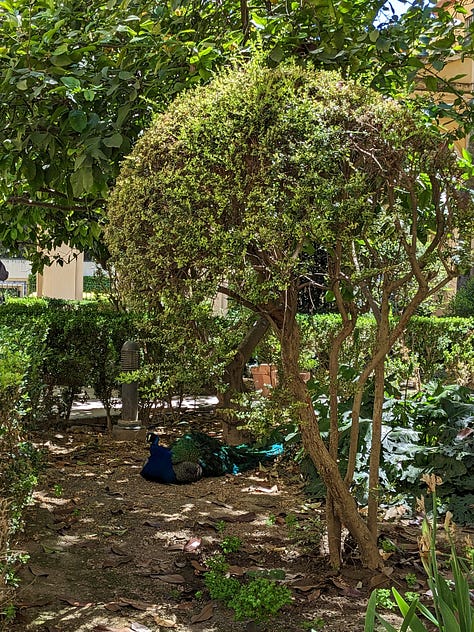
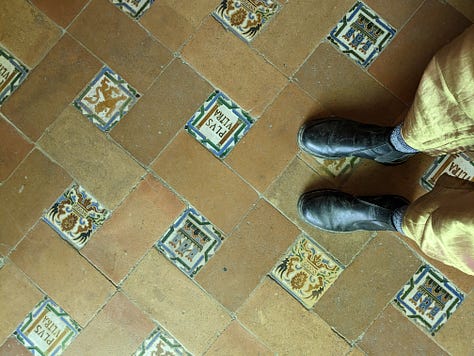
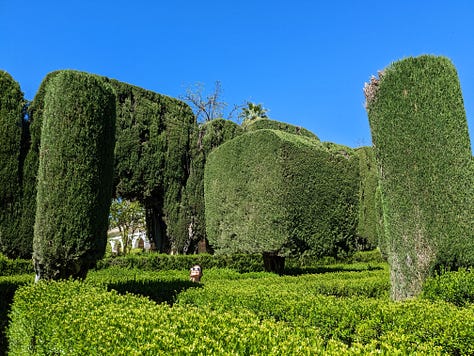
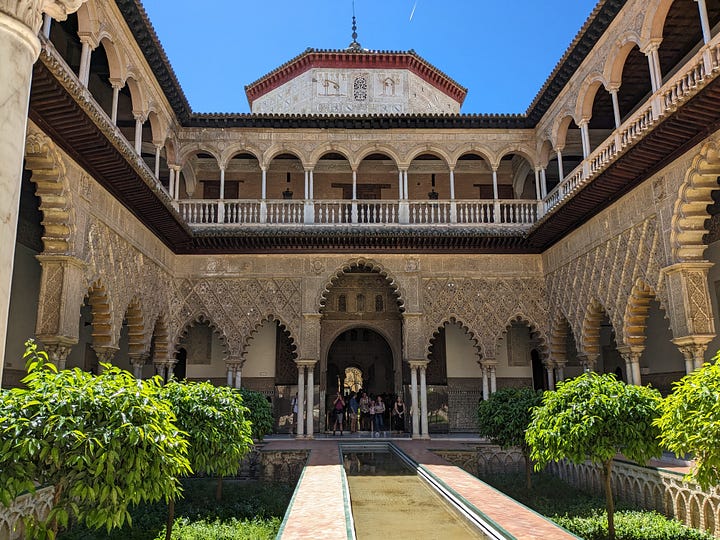
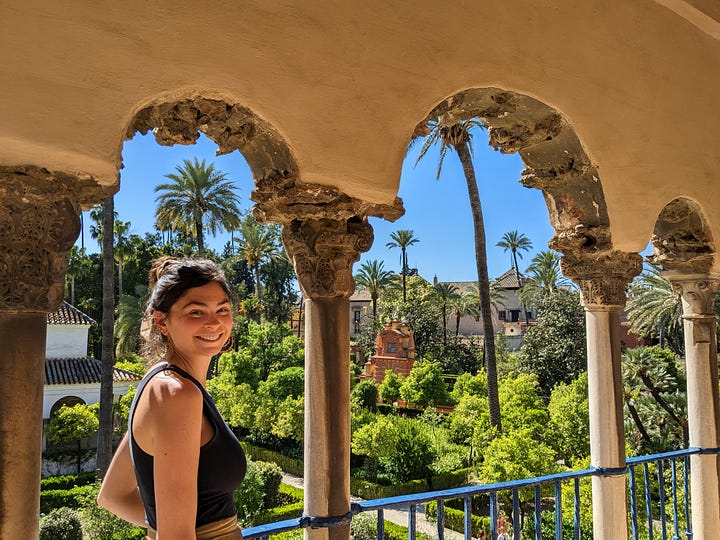
I would be remiss if I didn’t mention Harrison and my best cheap backpacking dinner hack: Ice cream. Post-dinner sunset walks with scoops, afternoon siesta cone moments, and late-night batidos (milkshakes) all hit different when you’re dying of heat stroke. All too often we would just replace a meal with some sort of frozen confectionery and call ourselves thrifty while downing a milkshake or licking a cone of pistachio and chocolate gelato.
Post-Alcazar, that is exactly what we did. We had ice cream for dinner before walking up to the doorstep of Peña Cultural Flamenca Torres Macarena, a traditional flamenco bar where tickets are sold at the door only.
Harrison grew up listening to flamenco because his mother had taught Spanish and studied in Madrid, so he had done his research on flamenco shows in Seville and landed on this place. At first, it was but a wooden door a little outside of the city and down a discreet alley, but it ended up being one of the best things we did in Seville. We bought our tickets and walked into a room filled almost exclusively with older Sevillans. Signs on certain chairs in the small and modest room read “reservado,” as there was a club for those who came to shows here frequently. There was a bar in the back serving beer, wine, and snacks such as olives, tortillas, and gazpacho. We were very happy to feel like we were observing a real slice of Sevillan culture.
The show ran from 8pm to midnight, with a 45-minute interlude. I had never really listened to flamenco, and this was truly authentic flamenco, so it was initially almost jarring to my ears. By the end, I was hooked. Once I got used to the singer’s voice, I could appreciate the deep, almost raspy quality it had. So very different from anything I’ve heard canonically qualify as “good singing,” it was fascinating to hear something so different from the voices with which I grew up.
We walked back to our hostel at midnight, finally content that we had gotten a glimpse into the true heart of the city. While Alcazar Palace was beautiful, the spirit of a place seems often to reside outside of its monuments, uninhabited palaces, and stately, largely unused churches. In this case, we found it in a small flamenco venue on a Saturday night.
día cuatro: a very long walk
In our almost four-month stint of travel, Harrison and I took several exceedingly long walks, with these meanderings often taking us outside of the normal touristic range of a place. On our fourth day in Seville, we had walked most of old town extensively and decided to explore the other side of the city across the river. We ended up walking about 10 miles total, seeing no grand churches, palaces, or courtyards, but rather getting a glimpse of where most Sevillans live: pretty run-of-the-mill apartment complexes on the outskirts of town that were not too far a cry from many in the US. For as much as I romanticize Europe, seeing these realities helps me to appreciate where I come from and live—as in it’s not all just sunshine and daisies over in Seville. Staying within the traditional parameters of somewhere as beautiful as Seville’s old town can often convince you otherwise.
While walking along this side of the river—which was less picturesque in that the buildings were built primarily for utility, without a flanking of beautiful riverside bars and restaurants—we remembered that it was Sunday, giving reason for the eery quiet that we felt had imposed itself upon the streets. Particularly in Spain, you can count on Sunday mornings being incredibly quiet, with very few businesses open and people about.
Aimlessly wandering through this silence, with the riverbank as our only guide, we passed yet another display of sweets that caught our attention—piles of cookies and cakes and, most importantly, several beautifully massive varieties of palmeras.
I looked at Harrison and I didn’t even ask him if he wanted one. I knew he would endorse my purchase of a palmera. After all, we had no idea how long we were gonna be walking; we needed provisions.
I waltzed inside and was met with EVEN MORE options behind a second pastry case counter. Chocolate palmeras, palmeras sprinkled with nuts, vanilla palmeras, caramel palmeras. But I knew which one was the palmera for me: the Zebra Cake-looking palmera.
I don’t remember how much it was, but I don’t think the massive pastry was more than 3 euro. I walked out feeling so appreciative of my status as an adult, with money to spend on gloriousness such as this and with no one to tell me I couldn’t have it as my lunch.
Harrison and I plopped onto a bench overlooking the river and bit into our fountain of health. It was incredible. The vanilla frosting was reminiscent of that of a petit four and the chocolate drizzle had almost a fudge-like quality. The texture was perfect; wonderfully balanced in flakiness and moisture. One of the best pastries we had in our four month backpacking stint, without a doubt.
After alternating bites and eating about 1/2 of the palmera, we picked up and continued walking along the river, using the unique greenway-like path slightly reminiscent of the Atlanta Beltline. Coming upon a massive roundabout brought us to a few roadblocks: it appeared as though a race of some sort was taking place and paths had been marked off due to its commencement. No sooner had we wondered what type of race it was that a few bikes came zooming past us. They were followed a half-minute or so later by another group of cyclists, then another. A lovely Sunday morning road race, again breathing humanity into a city whose bones could sometimes seem too old to still hold life.
We altered our path and ended up in a massive, flat, grassy park filled with citrus trees. Bright spots of orange dotted the bunches of leafy greens as well as the ground. Not only was the park scattered with the fallen fruits, but scattered across the grass and the intermittent wooden picnic tables were gatherings of families and groups of friends. A child’s birthday party was to our right. A group of young adults was grilling to our left. In front of us was a small group of people lounging on a picnic blanket in the shade. We took a seat on the edge of the scene and pulled out the rest of our palmera and sat in silence, observing.
I love just watching other people live their lives. I make jokes that thank God I’m a girl because it’s less creepy when I stare at people. I try not to do it in an odd manner—I am just simply so interested in how other people live. It’s one of the many reasons I love travel—I want to see how people in other parts of the world move through their days. How is it similar to my habits? How does it differ? What bearing does place have on birthing those similarities or differences?
It was in this citrus grove, stomach full of buttery and sugary perfection, so very hot and wildly in need of water, that I felt that, for the fourth time, I was finally getting that glimpse into Seville. Coupled with Bar Kiko, the flamenco show, and the bike race, I was satisfied with our detective work in lifting up the rock and finding what Seville was really like in the day-to-day. It is a city full of life if you look past the droves of tourists and the beautiful monuments. Its residents are the sturdiest representation of its activity: their utilization of the beautiful parks, the walkable and bikeable layout, and indulging in the deeply unique and pervasive culture all represented the truth of Seville beyond the buildings, plazas, and palaces.
In Porto and Lisbon, and later Barcelona, it had felt as though the locals were like reef fish and tourists were like sharks; as soon as they saw us, they stopped ambling about and hid in their reef homes. I don’t blame them—I’m from Charleston, a very touristed city (especially recently), and do not frequent the spots where tourists decide to clog up the streets like cholesterol in an artery. In Seville, it wasn’t quite as difficult to get that glimpse—so long as you were intentional about it.
Wherever I go, I feel as though I will always be a student in the art of blending in so as to see the fish interacting with their reef. Seville has waves of beautiful architecture, gardens, and delicious food and drink to boot, but the veins of culture that run through the city are carried instead by its inhabitants—and whatever experiences or interactions with them you can muster up are guaranteed to be your best souvenirs.
Because fuck a fridge magnet when you can have Bar Kiko’s mama nuggs.
list of recommended spots
Bar Kiko de la Chari (Calle Herbolarios, 17, Casco Antiguo, 41004 Sevilla, Spain)
Museo de Bellas Artes (Pl. del Museo, 9, Casco Antiguo, 41001)
Parque de Maria Louisa (P.º de las Delicias, s/n, 41013)
La Sacristia Tapas (C. Mateos Gago, 18, Casco Antiguo, 41004 Sevilla, Spain)
MUY coffee (Correduría, 14, local 3, Casco Antiguo, 41003 Sevilla, Spain)
Peña Cultural Flamenca Torres Macarena (C. Torrijiano, 29, 41009)

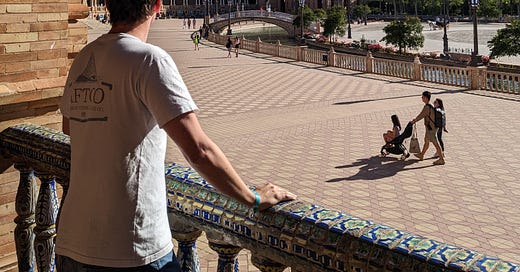


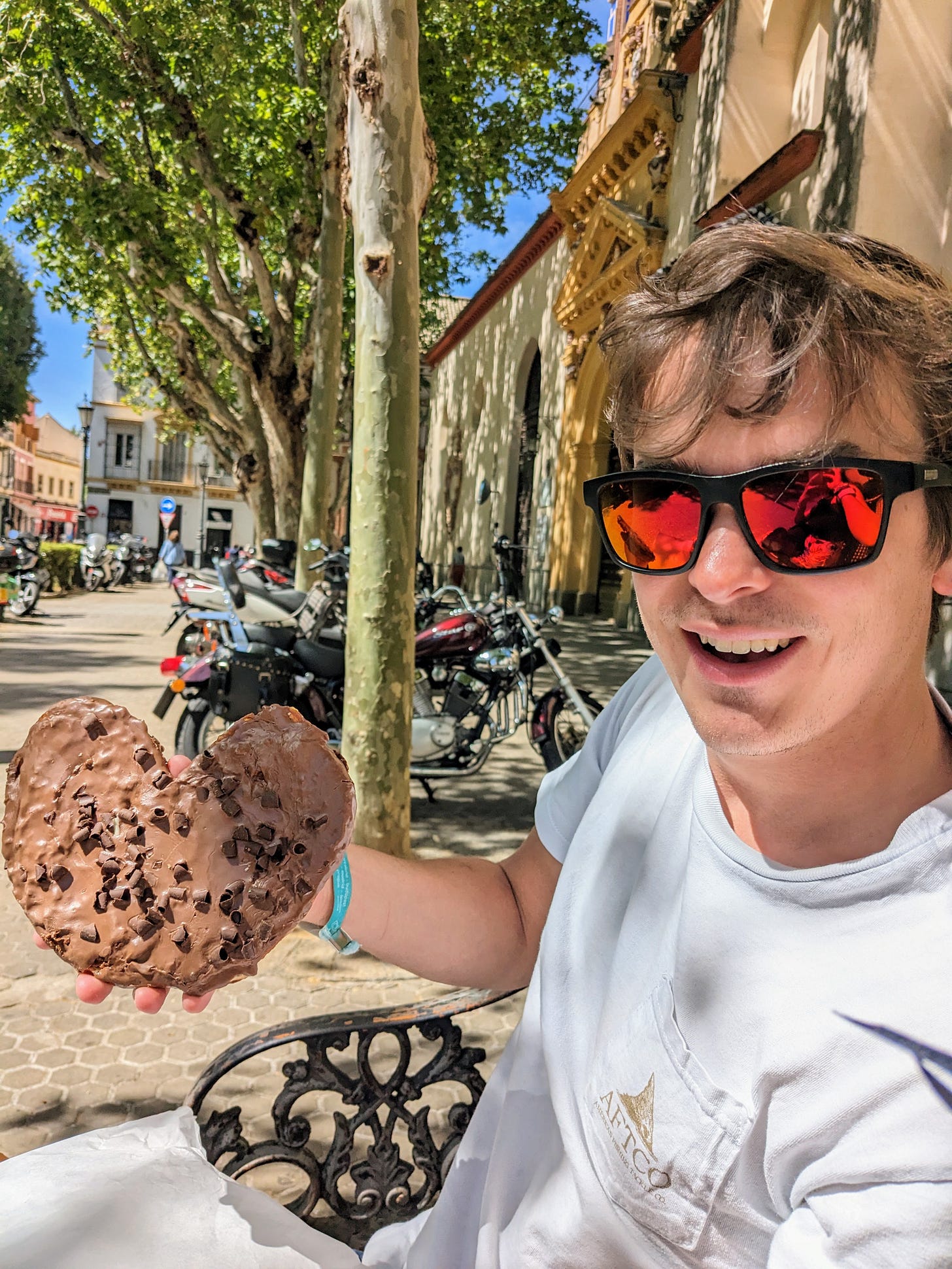
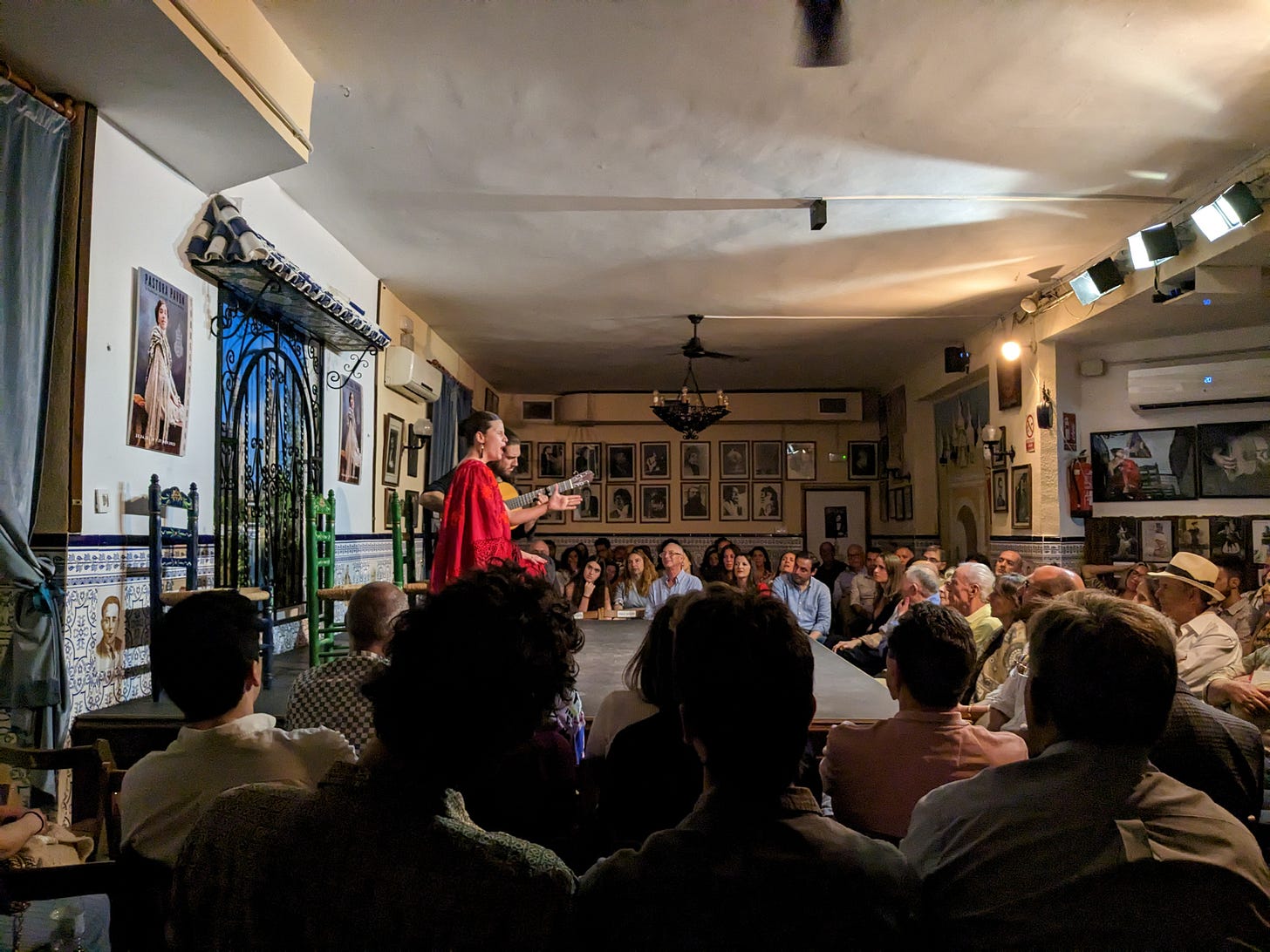
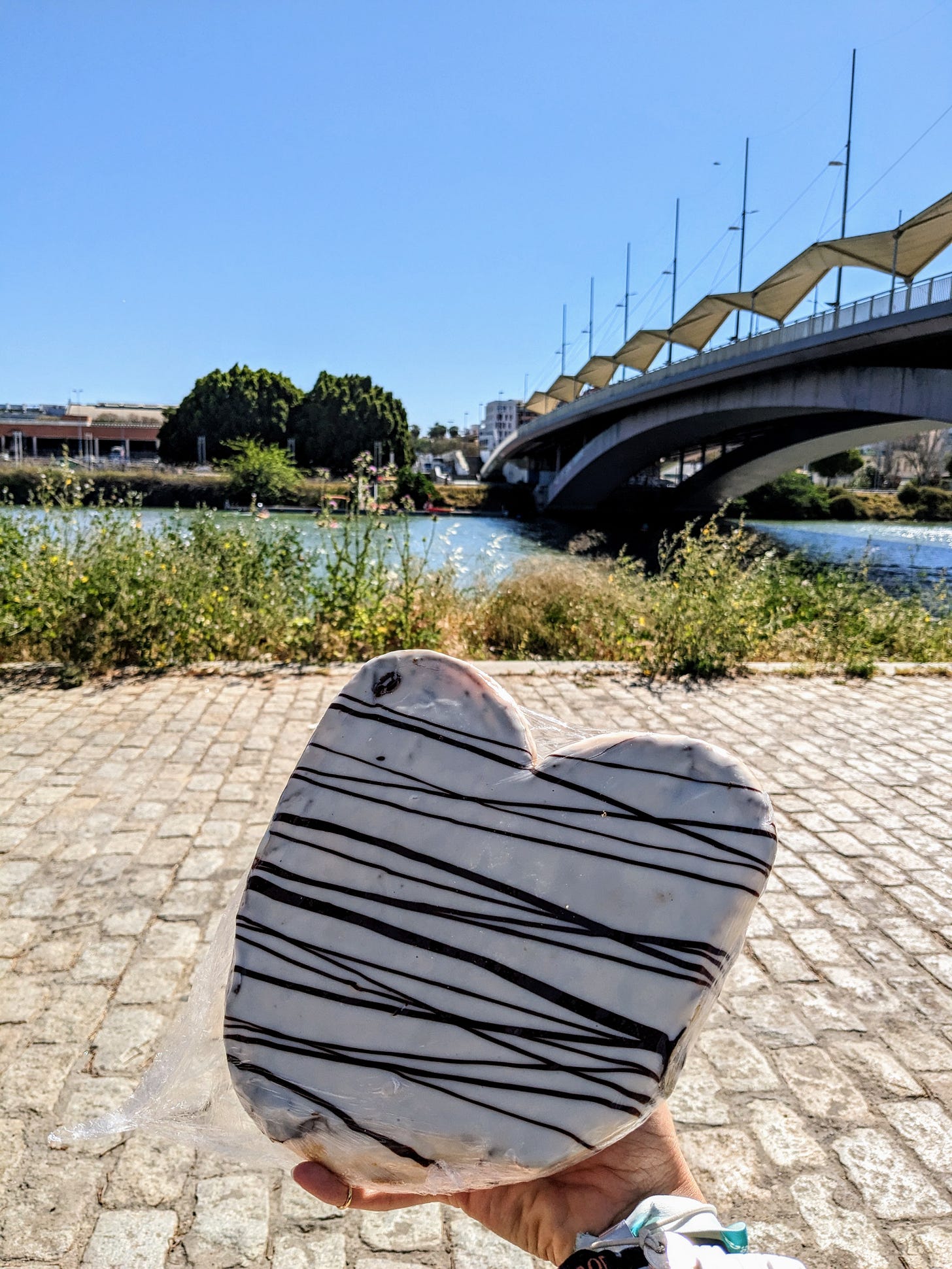
Okay, those palmeras look incredible 🤤 This was amazing Emily, definitely adding Seville to my dream destinations!